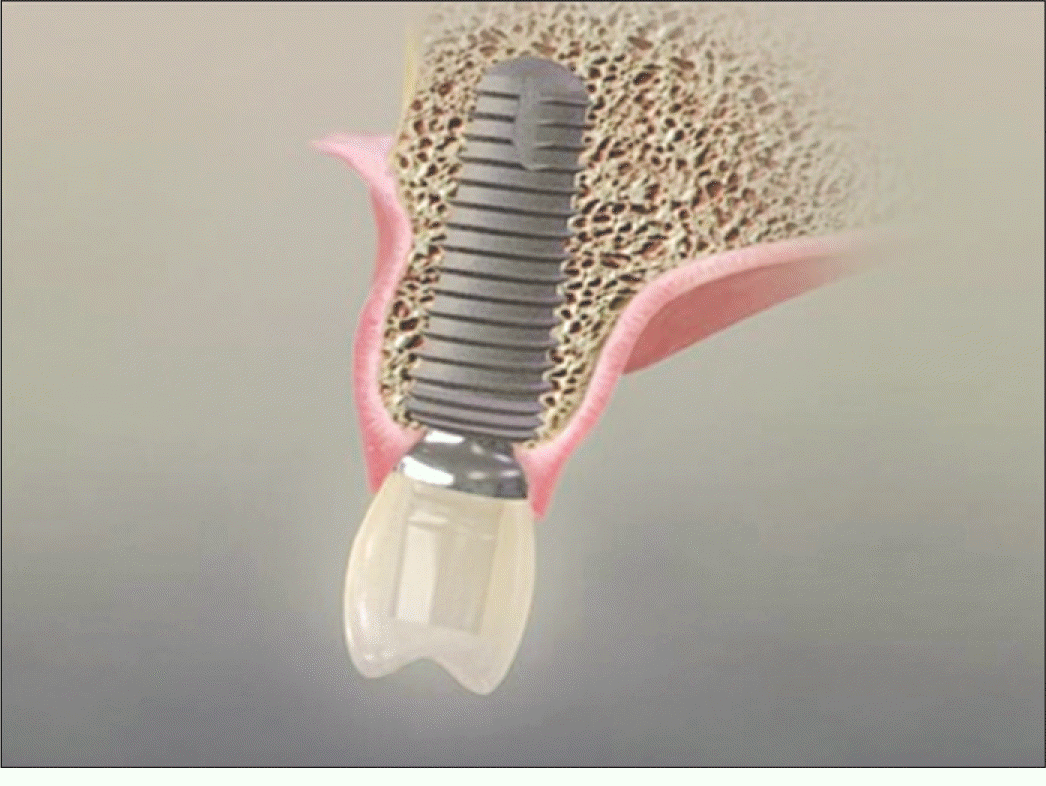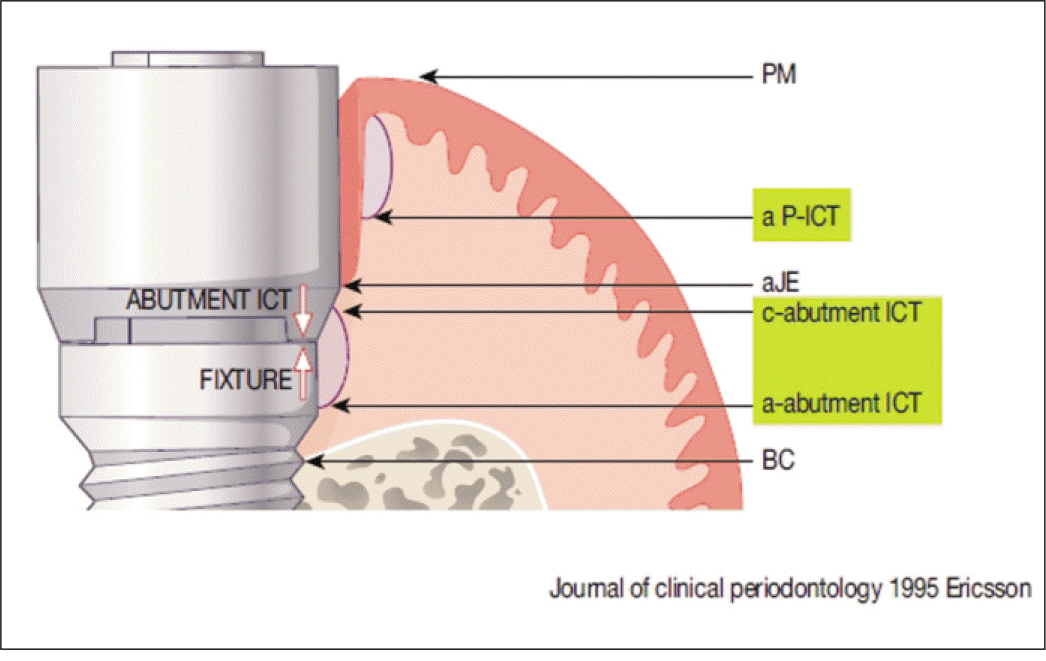Abstract
Purpose
The periimplant soft tissue is remodeled by the initial marginal bone resorption affecting the prognosis and esthetic result of treatment. Thus various designs on implant neck design are studied to preserve periimplant bone. The purpose of this study is to review on the causes of initial marginal bone resorption, the configuration of periimplant soft tissue, and the implant crestal module favorable in preserving periimplant tissue.
Materials and methods
The studies on the causes of initial marginal bone resorption and the implant crestal modules are researched and reviewed using Pubmed database. The implant crestal modules including one piece and two-piece implant, internal and external hex abutment, taper and butt joint connection, scalloped design abutment, and platform switching concept are reviewed.
Results
A number of clinical and experimental studies preferred one piece implant to two-piece in preserving initial periimplant tissue. For two piece implants, internal hex abutment and taper joint connection appear more favorable than external hex abutment and butt joint connection relatively. Controversial issues still exist on scalloped design requiring more studies on it. Although the rationale is not certain, the concept of platform switching seems favorable in preserving initial periimplant tissue based on clinical and experimental studies.
Conclusion
Each implant crestal module contains its own advantages and disadvantages with various controversial issues. In the aspect of preservation of initial periimplant tissue, however, one-piece implant seems beneficial. In cases when two-piece implant is more appropriate due to prosthodontic concerns or any other problems, the application of platform switching concept, internal connection abutment, and taper joint connection may be favorable for the preservation of periimplant tissues. (J Korean Acad Prosthodont 2011;49:346-53)
Go to : 
REFERENCES
1.Albrektsson T., Zarb G., Worthington P., Eriksson AR. The longterm efficacy of currently used dental implants: a review and proposed criteria of success. Int J Oral Maxillofac Implants. 1986. 1:11–25.
2.Misch CE., Perel ML., Wang HL., Sammartino G., Galindo-Moreno P., Trisi P., Steigmann M., Rebaudi A., Palti A., Pikos MA., Schwartz-Arad D., Choukroun J., Gutierrez-Perez JL., Marenzi G., Valavanis DK. Implant success, survival, and failure: the International Congress of Oral Implantologists (ICOI) Pisa Consensus Conference. Implant Dent. 2008. 17:5–15.

3.Davies JE. Mechanisms of endosseous integration. Int J Prosthodont. 1998. 11:391–401.
4.Wiskott HW., Belser UC. Lack of integration of smooth titanium surfaces: a working hypothesis based on strains generated in the surrounding bone. Clin Oral Implants Res. 1999. 10:429–44.

5.Kitamura E., Stegaroiu R., Nomura S., Miyakawa O. Biomechanical aspects of marginal bone resorption around osseointegrated implants: considerations based on a three-dimensional finite element analysis. Clin Oral Implants Res. 2004. 15:401–12.

6.Quirynen M., Naert I., van Steenberghe D. Fixture design and overload influence marginal bone loss and fixture success in the Branemark system. Clin Oral Implants Res. 1992. 3:104–11.
7.Ericsson I., Persson LG., Berglundh T., Marinello CP., Lindhe J., Klinge B. Different types of inflammatory reactions in periimplant soft tissues. J Clin Periodontol. 1995. 22:255–61.

8.Berglundh T., Lindhe J. Dimension of the periimplant mucosa. Biological width revisited. J Clin Periodontol. 1996. 23:971–3.
9.Hermann JS., Schoolfield JD., Schenk RK., Buser D., Cochran DL. Influence of the size of the microgap on crestal bone changes around titanium implants. A histometric evaluation of unloaded non-submerged implants in the canine mandible. J Periodontol. 2001. 72:1372–83.

10.Misch CE., Dietsh-Misch F., Hoar J., Beck G., Hazen R., Misch CM. A bone quality-based implant system: first year of prosthetic loading. J Oral Implantol. 1999. 25:185–97.

11.Isidor F. Histological evaluation of periimplant bone at implants subjected to occlusal overload or plaque accumulation. Clin Oral Implants Res. 1997. 8:1–9.

12.Quirynen M., van Steenberghe D. Bacterial colonization of the internal part of two-stage implants. An in vivo study. Clin Oral Implants Res. 1993. 4:158–61.

13.Persson LG., Lekholm U., Leonhardt A., Dahlen G., Lindhe J. Bacterial colonization on internal surfaces of Bra®nemark system implant components. Clin Oral Implants Res. 1996. 7:90–5.
14.Lindhe J., Berglundh T., Ericsson I., Liljenberg B., Marinello C. Experimental breakdown of periimplant and periodontal tissues. A study in the beagle dog. Clin Oral Implants Res. 1992. 3:9–16.

15.Berglundh T., Lindhe J., Ericsson I., Marinello CP., Liljenberg B., Thomsen P. The soft tissue barrier at implants and teeth. Clin Oral Implants Res. 1991. 2:81–90.

16.Abrahamsson I., Berglundh T., Wennstro¨m J., Lindhe J. The periimplant hard and soft tissues at different implant systems. A comparative study in the dog. Clin Oral Implants Res. 1996. 7:212–9.

17.Cochran DL., Hermann JS., Schenk RK., Higginbottom FL., Buser D. Biologic width around titanium implants. A histometric analysis of the implanto-gingival junction around unloaded and loaded nonsubmerged implants in the canine mandible. J Periodontol. 1997. 68:186–98.

18.Berglundh T., Lindhe J., Marinello C., Ericsson I., Liljenberg B. Soft tissue reaction to de novo plaque formation on implants and teeth. An experimental study in the dog. Clin Oral Implants Res. 1992. 3:1–8.

19.Zitzmann NU., Berglundh T., Marinello CP., Lindhe J. Experimental periimplant mucositis in man. J Clin Periodontol. 2001. 28:517–23.

20.Bullon P., Fioroni M., Goteri G., Rubini C., Battino M. Immunohistochemical analysis of soft tissues in implants with healthy and periimplantitis condition, and aggressive periodontitis. Clin Oral Implants Res. 2004. 15:553–9.

21.Iacono VJ; Committee on Research, Science and Therapy, the American Academy of Periodontology. Dental implants in periodontal therapy. J Periodontol. 2000. 71:1934–42.
22.Berglundh T., Abrahamsson I., Welander M., Lang NP., Lindhe J. Morphogenesis of the periimplant mucosa: an experimental study in dogs. Clin Oral Implants Res. 2007. 18:1–8.

23.Hermann JS., Buser D., Schenk RK., Cochran DL. Crestal bone changes around titanium implants. A histometric evaluation of unloaded non-submerged and submerged implants in the canine mandible. J Periodontol. 2000. 71:1412–24.

24.Heijdenrijk K., Raghoebar GM., Meijer HJ., Stegenga B., van der Reijden WA. Feasibility and influence of the microgap of two implants placed in a non-submerged procedure: a five-year follow- up clinical trial. J Periodontol. 2006. 77:1051–60.
25.Broggini N., McManus LM., Hermann JS., Medina RU., Oates TW., Schenk RK., Buser D., Mellonig JT., Cochran DL. Persistent acute inflammation at the implant-abutment interface. J Dent Res. 2003. 82:232–7.

26.Maeda Y., Satoh T., Sogo M. In vitro differences of stress concentrations for internal and external hex implant-abutment connections: a short communication. J Oral Rehabil. 2006. 33:75–8.

27.Levine RA., Clem DS 3rd., Wilson TG Jr., Higginbottom F., Solnit G. Multicenter retrospective analysis of the ITI implant system used for single-tooth replacements: results of loading for 2 or more years. Int J Oral Maxillofac Implants. 1999. 14:516–20.
28.Merz BR., Hunenbart S., Belser UC. Mechanics of the implant-abutment connection: an 8-degree taper compared to a butt joint connection. Int J Oral Maxillofac Implants. 2000. 15:519–26.
29.Pieri F., Aldini NN., Marchetti C., Corinaldesi G. Influence of implant-abutment interface design on bone and soft tissue levels around immediately placed and restored single-tooth implants: a randomized controlled clinical trial. Int J Oral Maxillofac Implants. 2011. 26:169–78.
30.Wo¨hrle PS. Nobel Perfect esthetic scalloped implant: rationale for a new design. Clin Implant Dent Relat Res. 2003. 5:64–73.
31.McAllister BS. Scalloped implant designs enhance interproximal bone levels. Int J Periodontics Restorative Dent. 2007. 27:9–15.
32.Nowzari H., Chee W., Yi K., Pak M., Chung WH., Rich S. Scalloped dental implants: a retrospective analysis of radiographic and clinical outcomes of 17 NobelPerfect implants in 6 patients. Clin Implant Dent Relat Res. 2006. 8:1–10.
33.Jansen VK., Conrads G., Richter EJ. Microbial leakage and marginal fit of the implant-abutment interface. Int J Oral Maxillofac Implants. 1997. 12:527–40.
34.Maeda Y., Miura J., Taki I., Sogo M. Biomechanical analysis on platform switching: is there any biomechanical rationale? Clin Oral Implants Res. 2007. 18:581–4.

35.Lo′pez-Marl′ L., Calvo-Guirado JL., Martl′n-Castellote B., Gomez-Moreno G., Lo′pez-Marl′ M. Implant platform switching concept: an updated review. Med Oral Patol Oral Cir Bucal. 2009. 14:e450–4.
36.Vigolo P., Givani A. Platform-switched restorations on wide-diameter implants: a 5-year clinical prospective study. Int J Oral Maxillofac Implants. 2009. 24:103–9.
37.Wagenberg B., Froum SJ. Prospective study of 94 platform-switched implants observed from 1992 to 2006. Int J Periodontics Restorative Dent. 2010. 30:9–17.
38.Tarnow DP., Cho SC., Wallace SS. The effect of inter-implant distance on the height of inter-implant bone crest. J Periodontol. 2000. 71:546–9.

39.Tarnow D., Elian N., Fletcher P., Froum S., Magner A., Cho SC., Salama M., Salama H., Garber DA. Vertical distance from the crest of bone to the height of the interproximal papilla between adjacent implants. J Periodontol. 2003. 74:1785–8.

40.Hermann F., Lerner H., Palti A. Factors influencing the preservation of the periimplant marginal bone. Implant Dent. 2007. 16:165–75.

41.Calvo Guirado JL., Saez Yuguero MR., Pardo Zamora G., Muñoz Barrio E. Immediate provisionalization on a new implant design for esthetic restoration and preserving crestal bone. Implant Dent. 2007. 16:155–64.
Go to : 
 | Fig. 2.Sealing around the soft tissue is excellent and adequate thickness could be maintained at the fixture-abutment interface in platform switching concept. |
Table 1.
Advantages and disadvantages of external hex abutment and internal hex abutment
Table 2.
Clinical outcome of platform switching concept




 PDF
PDF ePub
ePub Citation
Citation Print
Print



 XML Download
XML Download